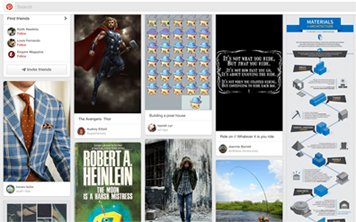Publishers need social referrals: so why have so few tapped into Pinterest?
 Mention Drudge Report to any web publisher and they’re likely to grow wistful and yearn for the days when a single link from the site could send their annual traffic sky-high.
Mention Drudge Report to any web publisher and they’re likely to grow wistful and yearn for the days when a single link from the site could send their annual traffic sky-high.
With few referral sites, small audiences and less competition, things were simpler for web publishers in the not-so-distant past. What traffic a site drew was usually direct, or via a search engine, and the volume of pages published on any given day often determined the size of the audience.
Fast-forward to today and the situation couldn’t be more different: the competition for eyeballs is more fierce than ever and (thanks to social media) the number of high-volume referrers has gone through the roof.
Sites now actively target key demographics across social networks like Facebook and Twitter in the hope of luring them away with engaging content.
With the grab for eyeballs keener than ever, this ability to use social media for high-quality referrals is an increasingly important way for publishers to ensure advertisers can be served with the audience demographic they need. All of which begs the question: if publishers are so keen to cosy up to referrers like Facebook and Twitter – why is Pinterest so overlooked?
Perhaps traditional publishers have been put off by the numerous hobby and handicraft pins, the scores of home decoration boards, and the endless pics of food that seem to dominate the site. If this is the case, they have really misjudged the type of content Pinterest could draw an audience for. But then, according to contemporaries at newer, more innovative sites, they might not have given it all that much thought.
Dao Nguyen, Buzzfeed’s vice president of growth and data, told Forbes that most publishers probably aren’t paying enough attention to Pinterest as a potential traffic source.
“Pinterest is huge. It’s giant,” Nguyen says. “It’s regular. I wouldn’t say it’s predictable, because very few networks are, but it’s untapped.”
Nguyen sought to dispell the myth that Pinterest’s users were only interested in hobby and home content. He told Forbes of the 100 Buzzfeed stories that have the most traffic from Pinterest, 30 per cent of the visits are to humorous posts. Pinterest, it seems, has the potential to help draw audiences to content of all types.
According to the most recent Shareaholic Social Media Traffic Report, Facebook and Pinterest are the ‘King and Queen’ of referrals. We all know about Facebook – and how publishers cosy up to it – yet, many big content sites don’t have a strong presence on Pinterest or even a way of actively drawing on its growing audience.
In March 2014 while Facebook drove 21 per cent of the overall traffic to published sites (not too surprising given how huge it is) Pinterest still managed to drive seven per cent of overall traffic to published sites. Not bad. If you consider that it’s next nearest rival, Twitter, drove just over one per cent, it’s marvellous.
By November last year, Pinterest was second only to Tumblr as the fastest-growing social network with growth in active users up by 111 per cent compared to Tumblr’s 120 per cent.
So, if it’s growing so much, and is such an important referrer, where is all that traffic going? Well, it seems lots is going to Buzzfeed (as well as probably helping create social media jobs on other sites too).
Buzzfeed has been producing content specifically intended for sharing on Pinterest for more than two years, says Forbes, and as a result Pinterest is already Buzzfeed’s second biggest source of social referrals – ahead of Twitter.
Buzzfeed takes Pinterest so seriously it has an internal ‘Pin Ops’ group whose members meets regularly and compare notes. It has even shared insights with rival publishers at the Pinterest developers’ conference.
With Buzzfeed so far out in front when it comes to understanding how to get referrals, what are other publishers to do? Well, at the risk of being glib, perhaps first they could optimise, then once they’ve mastered that start doing exactly what Buzzfeed does…